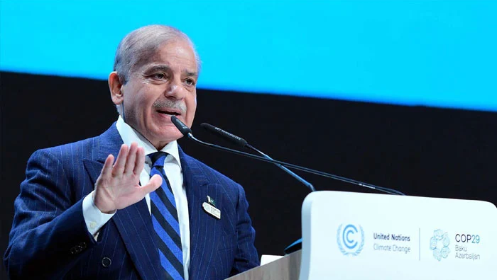Pakistan must push for an ambitious and equitable New Collective Quantified Goal (NCQG), an expanded Adaptation Fund, a fully operationalised Loss and Damage Fund, and a fair and transparent carbon market system under Article 6 of the Paris Agreement.
As negotiations unfold at COP29 in Baku, Pakistan stands at a critical juncture in its climate journey – one that is marked by both immense vulnerability and resilient ambition. With a population of over 235 million people, many of whom rely on agriculture for their livelihoods, Pakistan’s future is inextricably linked to its ability to adapt to the growing impacts of climate change.
The country’s geographic and climatic diversity – from the scorching deserts of Balochistan to the glacial peaks of the Himalayas – has exposed it to some of the most severe climate shocks in recent history. The catastrophic floods of 2022, which displaced more than 33 million people and caused damage exceeding $14 billion, serve as a stark reminder of the urgency of addressing climate risks.
Pakistan’s climate finance needs are not theoretical; they are based on a clear, evidence-backed understanding of the country’s vulnerability and the scale of the climate challenge it faces. However, despite these needs, international climate finance flows to Pakistan have been far lower than required. For instance, the Green Climate Fund (GCF), one of the most significant international funding mechanisms for climate action, has provided Pakistan with just $249 million as of 2024 – an amount that falls drastically short of what is needed to address the country’s growing climate crisis.
The gap is even more alarming when we look at Pakistan’s projected climate finance needs from 2023 to 2030, estimated at $348 billion which consists of $152 billion (44 per cent) to support adaptation and resilience and $196 billion (56 per cent) for mitigation.
With current funding flows ranging between $1.4 billion and $2 billion annually, it is clear that Pakistan is nowhere near receiving the necessary financing to address its climate challenges. This stark disparity between need and available funding highlights the fundamental inequity in the global climate finance architecture.
However, as Pakistan is engaging with the international community at COP29, the question remains: how can the country effectively negotiate for its climate needs while advocating for the principles of equity and justice, particularly when it comes to securing financial resources, scaling adaptation efforts, and establishing market mechanisms?
At COP29, Pakistan must take a firm stance, demanding that the global community adhere to the principles of equitable development – an approach that ensures developing nations, like Pakistan, receive the support they need to confront the overwhelming climate challenges they face. This includes negotiating strong and actionable outcomes on the New Collective Quantified Goal (NCQG) for climate finance, the Adaptation Fund, the Loss and Damage Fund, and carbon markets under Article 6 of the Paris Agreement.
Pakistan’s negotiation strategy should emphasise the undeniable reality that it bears little responsibility for the global emissions crisis, yet it faces disproportionate impacts from the resulting climate disasters. It is imperative that Pakistan’s calls for increased financial flows, climate justice, and equitable development are not only heard but acted upon at COP29.
One of the most pressing issues for Pakistan at COP29 will be securing adequate and predictable climate finance to address the country’s adaptation and mitigation needs. As the country continues to reel from the economic and social impacts of climate-induced disasters, Pakistan must take the lead in advocating for a robust New Collective Quantified Goal (NCQG) on climate finance post-2025. This goal, which builds upon the promise made in the Paris Agreement to mobilise $100 billion annually in climate finance for developing countries, must be significantly scaled up to meet the urgent needs of nations like Pakistan, whose climate vulnerabilities are growing at an alarming pace.
For Pakistan, the NCQG must ensure that climate finance is not just a political pledge but a legally binding commitment that translates into tangible outcomes.
Pakistan’s strategy must be grounded in the understanding that the principles of equity and common but differentiated responsibilities (CBDR) must guide the mobilisation of climate finance. Developed nations, which have contributed the most to the climate crisis, must step up and honour their financial commitments. Pakistan should push for a more ambitious NCQG that not only scales up the climate finance target but also ensures that finance is allocated in a manner that prioritises adaptation in the most vulnerable regions, including Pakistan’s flood-prone Indus Valley, arid deserts, and coastal areas at risk from sea level rise.
Adaptation is Pakistan’s most urgent priority given its severe vulnerability to climate change, with water scarcity, frequent flooding, agricultural disruptions, and escalating heatwaves threatening its agricultural sector. The Adaptation Fund is crucial for addressing these challenges, but it has not received the necessary investment to meet growing needs. Pakistan must take a leading role in advocating for a replenished and expanded Adaptation Fund, focused on community-based adaptation, ecosystem restoration, and water management, which are critical to its resilience.
Projects like the Living Indus Initiative (LII) and priorities under the National Adaptation Plan should be prioritised for funding. Additionally, Pakistan must push for simplified access to the fund, ensuring that resources reach vulnerable communities swiftly. In parallel, Pakistan must advocate for the Loss and Damage Fund, a vital mechanism for countries facing irreversible climate impacts.
With Pakistan’s minimal contribution to global emissions yet disproportionate vulnerability, the fund must operate on the principle of climate justice, ensuring that resources are allocated transparently and expeditiously to help countries like Pakistan recover from extreme weather events, such as the 2022 floods, and build long-term resilience.
As Pakistan looks towards the operationalisation of Article 6 of the Paris Agreement – which facilitates international carbon markets, carbon pricing, and emissions trading – it must ensure that carbon market mechanisms are designed in a way that benefits developing countries rather than exacerbating their vulnerabilities. While carbon markets can provide new revenue streams and investments for climate mitigation, equity must remain at the centre of negotiations to ensure that the environmental integrity of market mechanisms is upheld.
Pakistan should advocate for capacity-building initiatives that help developing nations, especially those with limited financial and technical expertise, to actively participate in carbon markets. Carbon trading should not be a tool for outsourcing responsibility, but a mechanism that provides fair compensation to countries like Pakistan for their role in mitigating global emissions.
At COP29, Pakistan must centre its negotiation strategy on climate justice and equitable development, advocating for climate finance to be allocated based on vulnerability and need, rather than economic status. The country should push for increased, accessible, and flexible financial flows that align with the urgent needs of the most affected populations.
By leading South-South cooperation, Pakistan can unite vulnerable nations to secure essential financial instruments for adaptation, mitigation, and loss and damage, positioning itself as a strong voice for global climate justice in Baku.
The writer is an environmental scientist and works at the Sustainable Development Policy Institute (SDPI) as head of ecological sustainability and circular economy.





